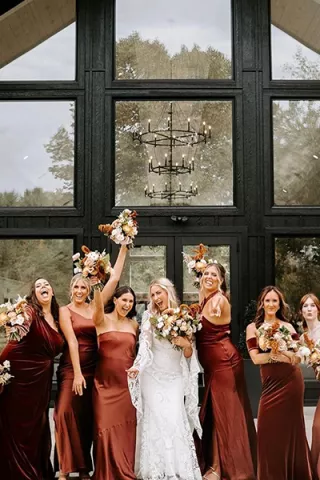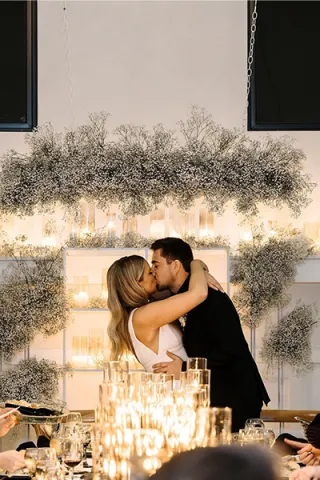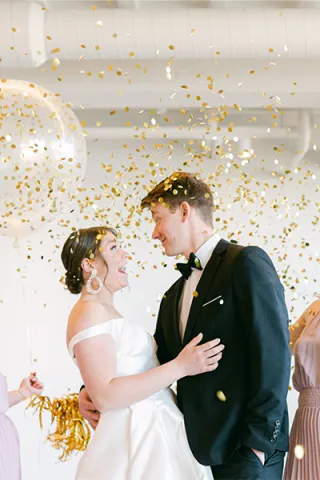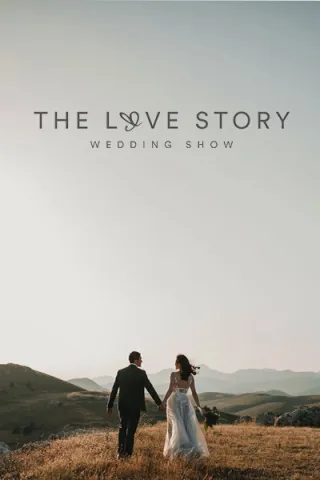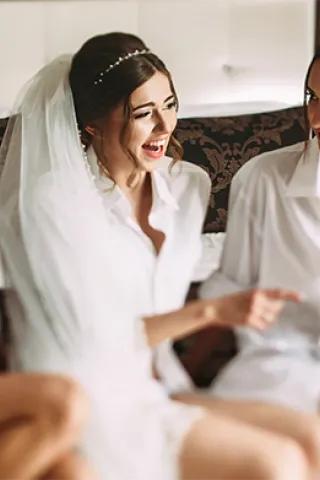“The ceremony is the most personal moment of the wedding,” says Martha Gabler Lunde, owner and designer at Martha’s Gardens in Saint Paul. She works with many brides to design flowers for both the ceremony and reception. She points out: “The reception is sharing the joy and the strength that comes from our friends and our families. But the binding piece is the ceremony.”
So take the time to make the most of those few indelible, heart-pounding moments. You won’t regret it.
THE BASICS
To the surprise of many brides, wedding ceremonies have a lot of leeway. While traditional religious ceremonies and those conducted in a church have certain requirements for various reasons, from a legal standpoint, very little must be included.
“The legal requirements for a marriage ceremony are absolutely minimal,” says District Judge Thomas Armstrong, assigned to Washington County. “Basically, I have to be assured that the two of them want to be married.”
Armstrong officiates at ceremonies all over the Twin Cities metropolitan area and, like many officiants, has several ceremony templates that couples can customize. He advises taking four to six months before your wedding date to prepare your ceremony, especially for choosing an officiant.
Who officiates at your wedding ceremony can be a personal decision in and of itself. Many couples chose childhood pastors, the religious official at a parent house of worship, or family friends.
Some couples even have a friend or family member ordained online, specifically so they can preside over their wedding. But make sure that won’t detract from the atmosphere you want.
MIXING TRADITIONS
Sometimes personalizing the ceremony is a must. Couples who come from mixed faiths often incorporate both traditions into a very personal service. For their August 2006 wedding, Molly Rutzick and her husband Ryan borrowed from their respective religions; Molly is Catholic and Ryan is Jewish. Their ceremony at the Saint Paul College Club was a unique, if occasionally demanding, mixed-faith ceremony.
“We knew first and foremost we wanted some sort of presence from both faiths, but it was a more challenging to arrange that,” says Rutzick. Their first thought had been to have both a priest and rabbi present, but the rabbi wasn’t comfortable with that arrangement. So they chose Judge Richard Spicer, a family friend of Ryan’s, to officiate.
They asked the rabbi to be present, without the Catholic priest, and they were married under a chuppah, a traditional canopy used in Jewish weddings, constructed by Ryan and his friends. A deacon from the Basilica of St. Mary in Minneapolis then joined them at the reception and gave a blessing.
Liza Atkinson and her husband Rob also has a mixed-faith marriage, but rather than blending faiths at the ceremony, they went church-hunting before they were even engaged to find a place of worship that met both their needs. Rob was raised Catholic, Liza was raised Lutheran and neither wanted to convert. So after a year and half they found Westminster in downtown Minneapolis, a Presbyterian church with traditions they both found appealing. They were married there in October 2005.
“We have strong faiths and wanted to get married in a church, but we wanted it to be our church, a place we were connected to and have a relationship with in the future,” says Atkinson.
VOWS & READING
Some of the most beautiful and memorable parts of a wedding ceremony are the words of love and commitment you and your fiancé recite to each other. The readings, the prayers and vows are all very personal statements and should be crafted with care.
“Every marriage and every relationship is different,” says Judge Armstrong, adding, “When two people marry, they should have something that fits them. Couples should have control over every word that’s said at their ceremony.”
The place where most couples personalize is the vows. Vows are the promises you make to one another as you enter into marriage together. An easy way to get started, says Albertson, is to remember why you’re getting married in the first place.
“There’s no one vow that fits everybody,” says Albertson. “I ask them questions, such as, ‘Why have you chosen to marry this person? Why did you say yes?’ It allows them to express their views and for the vows to be very special to them.”
Readings are another way to incorporate personal touches. During their August 2006 wedding at the Minnesota Boat Club in Saint Paul, Megan Smith and her husband Patrick included a reading from The Little Prince by Antoine de Saint-Exupéry. High school sweethearts in Huntsville, Ala., Megan and Patrick had gone to college thousands of miles apart. When they married in their adopted hometown, it was important to her that a reading from the book was incorporated.
“I had given the book to Patrick when we were younger, when we went away to college,” says Smith. “So it was a very personal reading to us.”
UNIFICATION SYMBOLS
Wedding rings aren’t the only symbols of unity during a wedding. Unity candles, sand, even rocks can be used as symbols of commitment. The unity candle is a tradition that many couples incorporate in their ceremony. But if your ceremony takes place outdoors or in a venue that doesn’t allow open flame, there are other ways to incorporate a tradition that signifies your oneness with your spouse, such as a sand ceremony.
In this ceremony, the couple, sometimes the parents, or sometimes both, are each given a separate color of sand. During the ceremony, each person or couple pours their sand into a single large vase; it demonstrates the impossibility of separating grains of sand, just as the union they celebrate that day will be inseparable. Afterward, the sand can be displayed in the couple’s home as a memento of their wedding day.
The elemental mineral world played a sentimental part in Emily Perry’s wedding to her husband Charlie in September 2006 in Alexandria. She wasn’t keen on a guest book, a tradition she thought impersonal. “The guest book would sit in a box,” says Perry. “And I would never look at it.”
Perry’s husband owns a landscaping business, so they had guests sign their names on decorative rocks they purchased at a Michaels craft store. “We put the rocks in a big vase and it sits by our front door,” says Perry. “I see it everyday.”
ATMOSPHERE
Creating a sacred space in a hotel ballroom or other secular venue can be difficult, especially if the reception is taking place in the same room. Even some churches have very little ornamentation and many brides chose to personalize their ceremonies with décor.
“I like to create a really beautiful aisle,” says Mary Regan, owner of Arch Angels Wedding Décor in St. Cloud. Regan works with everything from pillar candles, tulle and lights to emphasize the aisle. “It’s the main thing, the focal point of a ceremony.”
Flowers can add a very personal touch, too. Lunde of Martha’s Gardens adds personalized floral details to ceremonies, such as including apple branches in the wedding décor of a bride who grew up near an orchard.
While some couples often choose flowers for the altar to commemorate departed loved ones, Perry used ribbons to call attention to friends still living but deployed in Iraq.
“Since they couldn’t be at our wedding, my husband and I wanted to remember them,” says Perry. Each of the men’s boutonnières bore a ribbon emblazoned with the name of a soldier serving in Iraq, handwritten by the florist. Although the names were small, it was a special touch that Perry and her husband knew was there, making the day even more meaningful.
That kind of thought is what makes a wedding memorable, says Regan. “The reception is so much work, so the ceremony doesn’t always get the attention or the forethought it deserves,” she explains. “But it’s really important. It creates that magical feeling for the whole day.”

